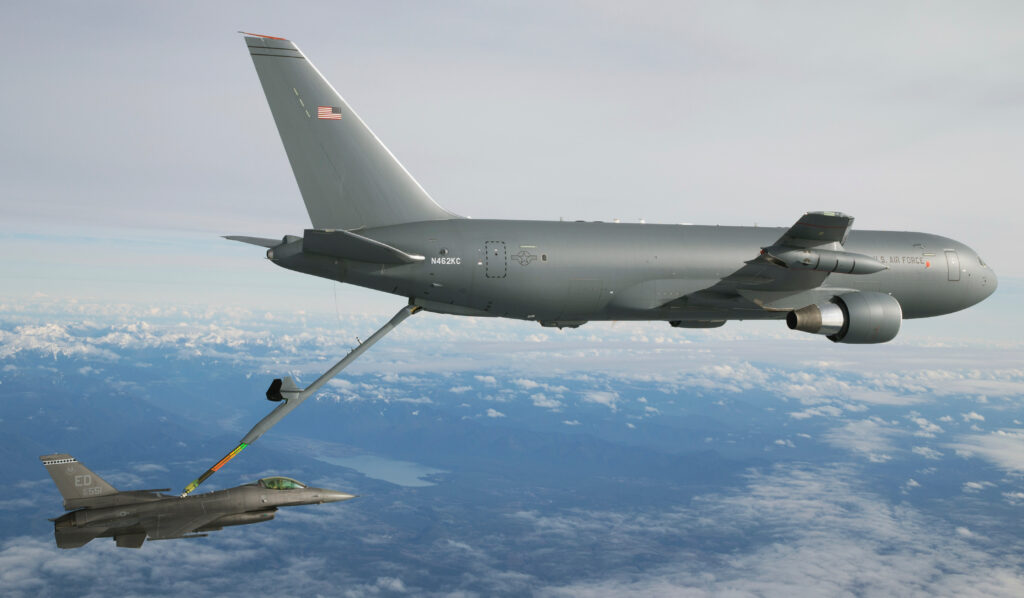
KC-46A
WASHINGTON: The head of Air Mobility Command says members of Congress and senior Air Force leaders have been “heartened” and a “little bit surprised” by progress made in moving the troubled KC-46 Pegasus tanker to limited operations, including some refueling missions.
Gen. Jacqueline Van Ovost, told reporters today that she briefed a congressional delegation, Air Force Chief of Staff Gen. CQ Brown and acting Secretary John Roth “earlier this week” — including flying them on the KC-46 as it refueled F-16 and F15 fighters. She said her team also has briefed leaders at Transportation Command on the “conditions-based” approach AMC is using to gradually bring the Boeing-built tanker into fleet operations.
“AMC is working hard to ensure that US Transportation Command has the tanker capacity necessary to meet Joint Force requirements,” she explained in a press briefing on the margins of the Air Force Association’s annual winter meeting. This includes “limited operational use of the KC 46 on a conditions-based approach.” For example, she said, approved uses “include aerial refueling F-16s participating in US-based training exercises.”
“You may be surprised to know that the KC-46 is already executing four to six missions daily in support of service and joint training missions,” she added. “In fact, since last October, the KC-46 executed more than 650 missions across the globe in all three of its mission sets. (Those are airborne re-fueling, cargo transport and passenger airlift including for medical purposes.)
However, the tanker will not be deployed for combat. “Be clear on three things,” Van Ovost said. “First, we will not use the KC-46 for full combatant command deployments until its serious deficiencies are fixed. Second, we can’t open the aperture on increased operational use of advanced warfighting capabilities like the KC-46 without divestment of some of our older tankers, and the ability to review further divestments annually. Third, increasing our operational use of the KC-46 will not slow the efforts to fix the remaining deficiencies.”
Bringing the KC-46 into limited use despite its continued operational deficiencies “will help relieve stress on the remainder of our tanker fleet by enabling the KC-46 to accept operational taskings from US Transportation command that would otherwise be filled by our heavily tasked KC-135s and KC 10s,” she explained.
“I am confident that accepting the KC-46 — with known deficiencies — offers the fastest route to fielding a fully operationally capable weapon system,” she said. “That said, serious deficiencies and restrictions remain with the KC-46 weapon system, and Boeing is still responsible for installing the Remote Visual System 2.0, and redesigning the boom telescope actuator. Ultimately, this approach will allow us to reach maturity faster in all facets of the KC 46 weapons system.” (The Remote Visual System 2.0 is the improved boom camera Boeing and the Air Force agreed in April to retrofit on the KC-46.)
The KC-46 isn’t expected to be fully operational — that is, able to take on the gamut of missions from medical airlift through aerial refueling — until fiscal year 2024, Van Ovost told the Defense Writers Group earlier this month.
Van Ovost clarified that the tanker is not yet all the way out of the woods. She also stressed that in order to be able to realize the full benefit of the KC-46 fleet, decisions will have to be made to retire some older tankers.
Meanwhile, AMC is reviewing how many off-the-shelf tankers it will need to buy to “bridge” capabilities provided by the KC-46 fleet once its fully operational and the development of a follow-on tanker. The Air Force hopes to have figured out a concept for that next-generation aerial refueling aircraft some time in 2022, Van Ovost told the Defense Writers Group.
Navy jet trainer fleet operations remain paused after engine mishap
One week after the incident, a Navy spokesperson says the service is continuing to assess the fleet’s ability to safely resume flight.


























